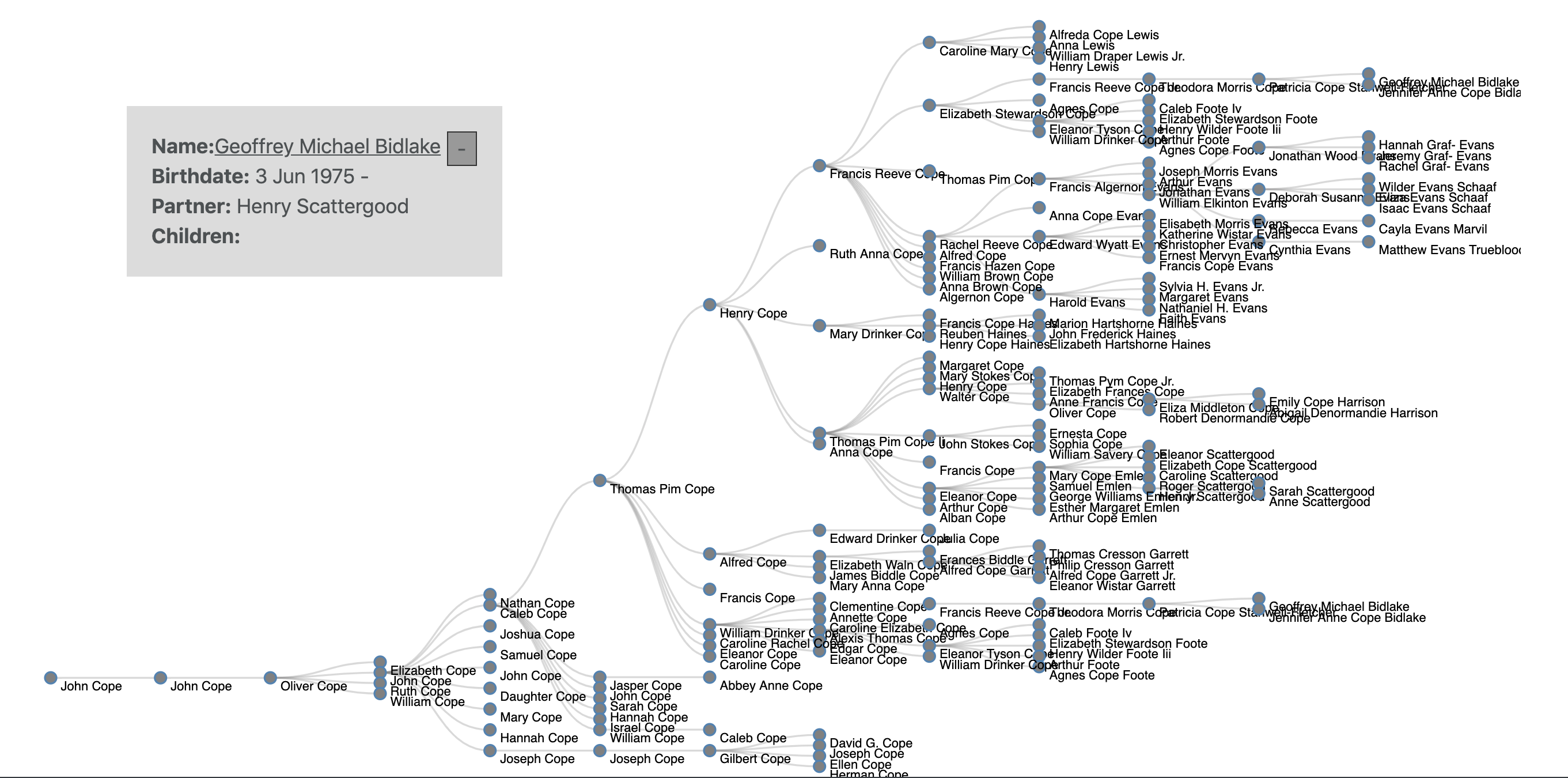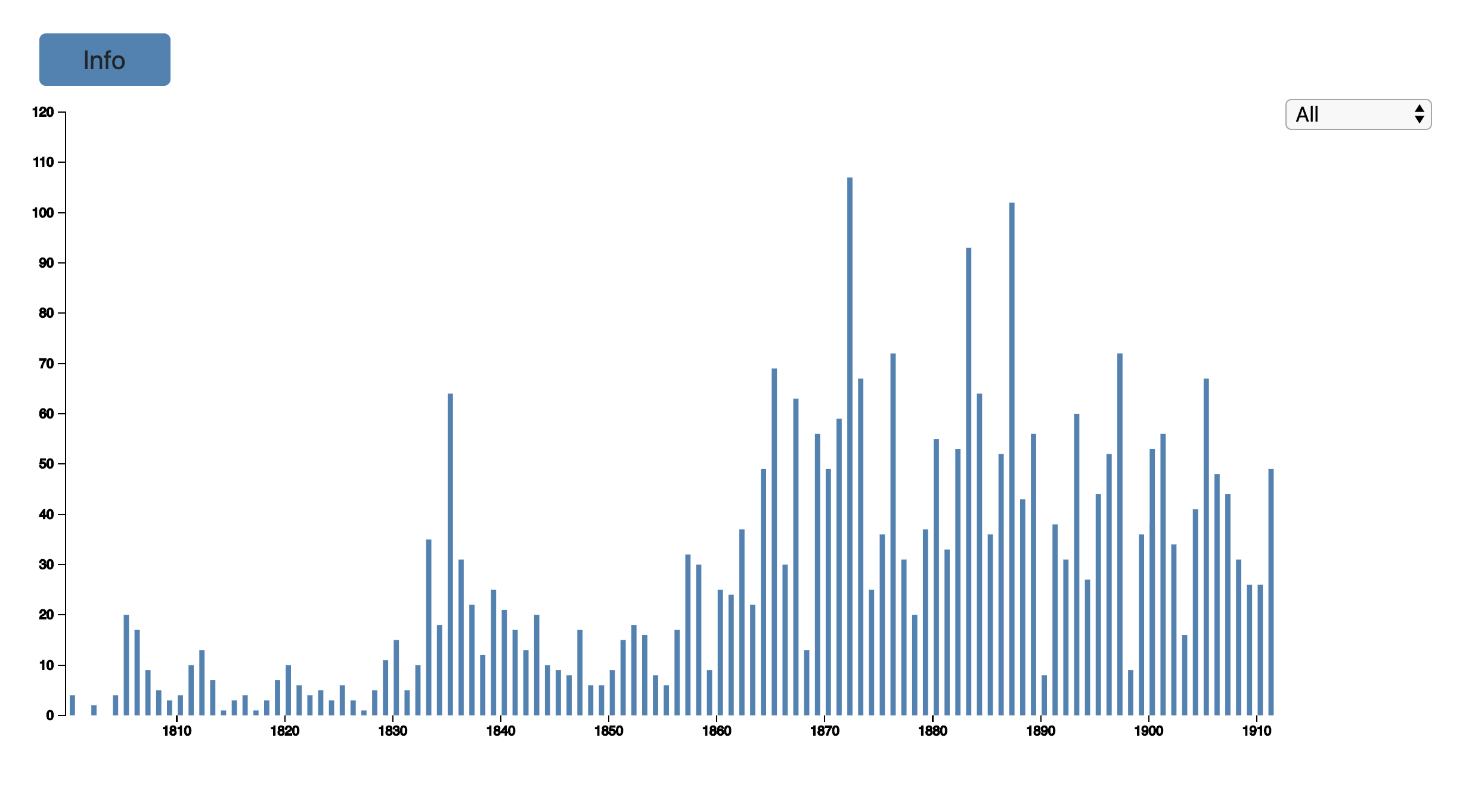The Cope Evans Family

Explore the family dendogram, a horizontally-oriented family tree, to see the Copes' and Evanses' familial connections. This family tree encompasses thirteen generations of Quakers dating back to the late sixteenth century with the birth of John Cope. In this tree you can see how prominent Quaker families such as the Copes, Evans, and Drinkers are closely connected by marriage.
Thomas Pim Cope (1768-1854), was a prominent Quaker merchant who was actively involved in the economic and social development of Philadelphia. He was born in 1768 to Caleb and Mary Cope in Lancaster, PA. Thomas P. Cope married Mary Drinker in 1792 and they had seven children: Henry (1793-1865), Francis (1794-1816), Caroline (died in infancy), William (1798-1873), Caroline R. (1802-1873), Alfred (1806-1875), and Eleanor (1807-1847) (refer to the Cope Family Tree) (Evans, 144; G. Cope, 51).
In late 1785 or early 1786, he arrived in Philadelphia from Lancaster County, Pennsylvania "to commence the acquisition of practical mercantile knowledge" (Chandler, 358). During his life, he served as a member of the Philadelphia City Council, Pennsylvania Legislature, and President of the Mercantile Library Company. Cope found financial success in his import-export business. His line of packet ships expanded networks between Philadelphia and Liverpool, England. Cope also provided financial support for one of the city’s major projects, the Pennsylvania Railroad. Cope identified as an Orthodox Quaker (Baltzell, 501, 440-441, Barbour and Frost, 187).
Francis Reeve Cope (1821-1909), the grandson of Thomas Pim Cope, was a merchant and businessman. In 1847, he married Anna Stewardson Brown and they had nine children: Elizabeth (1848-1937), Rachel (1850-1939), Thomas (1852-1944), William (1854-1860), Alfred (1857-1897), Francis (1859-1909), Algernon (1860-1862), Anna (1862-?), Caroline (1865-1953) (refer to the Cope Family Tree) (Evans, 144). He was involved with the Pennsylvania Freedmen’s Relief Association, a philanthropic effort established around 1862 to provide education for freed slaves (Benjamin, 76, 140-141, 128).
Jonathan Evans (1843-1911) was the fifth child of Thomas Evans and Katharine [Catharine] Wistar. He married Rachel Reeve Cope (1850-1939), daughter of Francis Reeve Cope, in 1873. They had five children: Anna (1875-1967), Francis (1878-1946), Edward (1882-1976), Ernest (1884-1911), and Harold (1886-1977) (refer to the Cope Family Tree). All four sons graduated from Haverford College (Evans, 22, 138, 143).
For nearly thirty years, Evans served on the School Committee at Haverford College. According to his colleagues “his influence stood for conservatism in retaining the best features that differentiate our Friends’ Schools from others; that at the same time he was always ready to adopt plans in accordance with progressive standards in education” (Minutes of School Committee, Reporting Jonathan Evans' Death, 1911; Evans, 138).
Clementine Cope (1835-1899) was the oldest child of William D. Cope (1798-1873) and Susan Newbold. She had two brothers, Edgar and Alexis, and had a close relationship with her sisters, Caroline and Annette. Her sister Eleanor died as an infant (refer to the Cope Family Tree). Clementine never married (Evans, 144; G. Cope, 112-113).
While the bustle of city life served as the arena for business affairs and reform efforts, letters written by the Cope and Evans families from Awbury and Woodbourne captured scenes of life at home. Awbury, the Cope family home for generations, was built by Henry Cope (1793-1865) in the 1850s. Its location in Germantown provided easy access to Philadelphia by train.
Woodbourne was another family home that was built by William Drinker Cope's son Alexis. Woodbourne served as a retreat for many members of the Cope family who hoped to escape the summer heat in Philadelphia. Located in a remote area, the home also included an orchard. Later, Alexis's son, Francis R. Cope, Jr., would explore his interest in farming and horticulture while living at Woodbourne.
Reports on the health of family members (with occasional reference to the nurses who attended them), stories of birthdays and weddings, and details regarding child care and chores were all important subjects in letters written by the women of the households.
Benjamin, exploring the changing roles of Orthodox Quaker women, suggests that while Quakerism embraced egalitarianism and "offered opportunities for women in the ministry," Philadelphia Quakers grappled with the issue of "grant[ing] women equality in the administration of their Meetings." Outside of the Meetings, Quaker women took roles as nurses, teachers, and social workers. Benjamin also notes that "two-fifths of the women in Philadelphia meeting never married" (Benjamin, 148, 164, 148-169).
The families' domestic lives and the experience of their women lead to many more questions of scholarly inquiry. For example, in what ways was Clementine Cope, a Quaker woman who never married and spent time abroad, representative of women during this period?

The chart here plots the number of letters on the y-axis, against the year the letters were written on the x-axis. Click on the image here to go to the interactive chart. To view how the letters are distributed by subject, go to the drop down menu on the side and select which subject you would like to view. The graph will then change to show the letter distribution by subject. This visualization is an exploratory tool for the collection. Many of the subjects that you can filter by are related to domestic and every day life of the family members. Filtering by subject areas like family, lifestyle, love, and travel will reveal the frequency of letters on those subjects betweeen 1800 and 1910.
Clementine Cope’s 1879 diary of her travels around Italy documented her interests in Roman mythology, art and sculpture, and ancient history (Woodbourne Orchards and family of Francis R. Cope Jr. Collection). Her letters addressed to her family were written from cities in Italy. She discussed Renaissance art, art museums, and food to name a few topics.
Her interests in all these subjects were evident in her scrapbook. A gift from her Aunt E.C. Tyson in 1844 when Clementine was nine years old, she filled it with illustrations from magazines such as Harper’s, photographs, poems, sketches and drawing, newspaper article clippings, and obituaries throughout her life. The illustrations certainly reflect a sense of romanticism and captured scenes of domesticity, the lives of royalty, and spiritual life. Newspaper clippings included a copy of Lincoln’s second inaugural address and stories about his assassination and funeral procession. Obituaries of Thomas P. Cope and Henry Cope are also included.
Click on the images above to flip through select pages of Clementine Cope's Scrapbook.

The map is compiled from the exchange of the writer or recipient's location pulled from all the digitized letters and documents in the Cope Evans Family Papers.